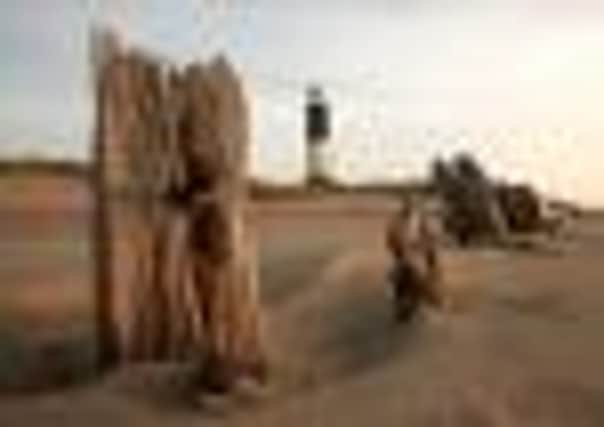Point of departure


There aren’t many places in Yorkshire that can claim to have the look of a Caribbean island, or have had a song written by Vaughan Williams in its honour or are classified as heritage coast. Spurn can claim all three.
Spurn Point (or Spurn Head or just plain Spurn, depending on who you ask) is the long, curved finger of land pointing out into the North Sea at the mouth of the Humber.
Advertisement
Hide AdAdvertisement
Hide AdMore accurately it’s a spit, three miles long and 50 yards wide in places. It’s made up of wild beaches, sand dunes, grassland and mudflats and if you look at aerial photographs taken above its enlarged, circular southernmost tip it genuinely looks like some exotic island in the Caribbean – well, on a good day it does, if you squint a bit. It’s a fine, bracing, handsome place, constantly shifting but hardly changing; it’s as fascinating and dramatic a location as you can visit in the whole of the UK and, best of all, no-one’s ever there. Well, hardly anyone.


Spurn is made (and constantly being re-made) of sand and shingle washed down the Holderness coast by the North Sea. The longshore drift gathers material from as far north as Flamborough and deposits it as it slows on convergence with the Humber. This leaves a peninsula which slightly changes shape every day and which entirely reconstructs itself every 250 years or so. During particularly high tides and in the right weather conditions Spurn has even been known to breech, leaving its southerly parts an island.
On Spurn’s western side the sand and shell beaches are constantly buffeted by the unrelenting North Sea. Even on the most clement summer days the fierce winds mean it can be a bit nippy and picnics are best enjoyed in the adjoining steep, sheltering sand dunes.
For sporting enthusiasts, though, conditions are perfect. Kite surfers love the tough seas and beach anglers are fulsomely rewarded by a bounty of cod, whiting and a variety of rays. More sedate beach visitors can enjoy fossil hunting as the non-stop tidal thrashing uncovers new specimens every day and the wide tidal range also creates constantly altering mini-sandbanks and rivulets to explore.
Advertisement
Hide AdAdvertisement
Hide AdDown the middle of the spit and at the headland are more of the aforementioned sand dunes as well as gorse and grassland which provide habitat for many species of butterfly, caterpillar, ladybird and even deer.


The plants also grow around the remains of decaying wartime defences; Spurn was an important point of strategic defence in the Second World War and the remnants of train tracks, artillery bunkers and other military miscellanea provide a vivid history lesson for the kids. In addition, there’s a very picturesque disused lighthouse but sadly a lack of funds and health and safety concerns mean its interior is not accessible to the public.
On the Eastern side, adjoining the Humber are mudflats, populated with a dazzling array of indigenous British birds and visiting rarities. It’s this aspect of Spurn which draws the most attention, with twitchers accounting for the majority of the peninsula’s visitors. Over two hundred species have been recorded and at Spurn’s observatory you can expect to see such delights as wheatears, whinchats and flycatchers as well as rarer sights such as the lanceloted warbler and the black-browed albatross, if you’re lucky.
Spurn is great for kids, as long as they’re not expecting amusements or an ice cream. Choose your own route and zigzag along between different landscapes to your heart’s content – a circuit of the whole peninsula is about seven miles and will take roughly four hours at a brisk pace.
Advertisement
Hide AdAdvertisement
Hide AdThe entire peninsula is accessible on foot, bike or car (some even ride horses) and none of its delights is ever more than a few minutes away. Remember that Spurn is a nature reserve so if you normally take you dog with you, it won’t be allowed past the gate.
Vaughan Williams was inspired by Spurn to write one of his Six Studies in English Folk Song for Cello about it and Philip Larkin was a regular visitor here.
In his 1964 poem Here, a line about “unfenced existence” is generally attributed to the feeling he had for the place and the way it lifted his feelings.
It’s a shame that more people don’t make the effort to head out there because there’s a rough, natural beauty about the place which may well stay in your memory longer than you’d expect.
GETTING THERE
Advertisement
Hide AdAdvertisement
Hide Ad* Spurn is a good 45 minutes drive past Hull. It’s about double that time heading south from Bridlington and if you’re travelling by bus, take a book. Accommodation options are limited. The only houses belong to the full-time lifeboat crew. There is a guest house in Kilnsea at the north end of Spurn. There is a nearby caravan park and you can secure beds at the observatory if you book well in advance.
* Drivers tend to travel the length of the spit and then park in the smallish car park near the lighthouse. The more adventurous visitor will park at the north end (where there’s an entry gate charging £3 per car, all proceeds to the Yorkshire Wildlife Trust) and walk the length of the spit.
* If you’re a day visitor, take a packed lunch. There is a snack bar but it opens infrequently and it can be a long old trek to the nearest pub.